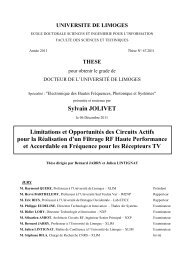Contribution à la conception optimale en terme de linéarité et ...
Contribution à la conception optimale en terme de linéarité et ...
Contribution à la conception optimale en terme de linéarité et ...
You also want an ePaper? Increase the reach of your titles
YUMPU automatically turns print PDFs into web optimized ePapers that Google loves.
Figure III.9 - Contours <strong>à</strong> puissance <strong>de</strong> sortie constante (Ps=120 mW, Zin(2f0)) .................... 98<br />
Figure III.10 – Influ<strong>en</strong>ce <strong>de</strong> l’impédance <strong>de</strong> charge <strong>à</strong> f0 ....................................................... 100<br />
Figure III.11 – Influ<strong>en</strong>ce <strong>de</strong> l’impédance <strong>de</strong> charge <strong>à</strong> 2f0 ..................................................... 100<br />
Figure III.12 – Influ<strong>en</strong>ce <strong>de</strong> l’impédance <strong>de</strong> source <strong>à</strong> 2f0 ..................................................... 101<br />
Figure III.13 – Caractéristique <strong>de</strong> bruit d’un amplificateur ................................................... 102<br />
Figure III.14 – optimisation <strong>en</strong> consommation ...................................................................... 103<br />
Figure III.15 – Rapport signal <strong>en</strong> bruit <strong>en</strong> fonction du nombre <strong>de</strong> cellules ........................... 104<br />
Figure III.16 – Comparaison <strong>de</strong> <strong>de</strong>ux amplificateurs............................................................. 105<br />
Figure III.17 – Critère d’optimisation.................................................................................... 106<br />
Figure III.18 – Equival<strong>en</strong>ce <strong>de</strong>s critères................................................................................. 106<br />
Figure III.19 – Lieu <strong>de</strong>s optima.............................................................................................. 107<br />
Figure III.20 – Banc <strong>de</strong> test.................................................................................................... 108<br />
Figure III.21 – Résolution graphique ..................................................................................... 109<br />
Figure III.22 – Algorithme d’optimisation............................................................................. 110<br />
Figure III.23 – Comparaison <strong>de</strong> <strong>de</strong>ux cellules ....................................................................... 112<br />
Figure III.24 – Application <strong>à</strong> <strong>la</strong> <strong>conception</strong> d’un amplificateur............................................. 114<br />
Figure III.25 – Lieu <strong>de</strong>s optima.............................................................................................. 115<br />
Figure III.26 – Influ<strong>en</strong>ce <strong>de</strong>s impédances <strong>de</strong> charge <strong>à</strong> f0....................................................... 116<br />
Figure III.27 - Influ<strong>en</strong>ce <strong>de</strong>s impédances <strong>de</strong> charge <strong>à</strong> 2f0 ..................................................... 117<br />
Figure III.28 – Répartition <strong>de</strong>s impédances simulées ............................................................ 118<br />
Figure III.29 – Influ<strong>en</strong>ce <strong>de</strong> l’impédance <strong>de</strong> source <strong>à</strong> 2f0 ..................................................... 119<br />
Figure III.30 – Influ<strong>en</strong>ce du point <strong>de</strong> po<strong>la</strong>risation ................................................................. 120<br />
Figure III.31 – Méthodologie <strong>de</strong> <strong>conception</strong> d’un amplificateur <strong>de</strong> puissance...................... 123<br />
FigureIV.1 – Comparaison mesures/modèle pour un fonctionnem<strong>en</strong>t <strong>à</strong> 2 porteuses............. 135<br />
FigureIV.2 – Facteur K <strong>et</strong> B sur <strong>la</strong> ban<strong>de</strong> [0-20 GHz]........................................................... 137<br />
FigureIV.3 – Exemple <strong>de</strong> topologie perm<strong>et</strong>tant <strong>de</strong> stabiliser un transistor............................ 137<br />
FigureIV.4 – Cercles <strong>de</strong> stabilité du transistor HFET............................................................ 138<br />
FigureIV.5 – Impédances <strong>optimale</strong>s <strong>et</strong> leurs cycles <strong>de</strong> charge associés ................................ 140<br />
FigureIV.6 – Caractéristiques C/(N+I3) ................................................................................. 141<br />
FigureIV.7 – C<strong>la</strong>sse AB légère .............................................................................................. 142<br />
FigureIV.8 – C<strong>la</strong>sse AB profon<strong>de</strong>.......................................................................................... 142<br />
FigureIV.9 – Principe d’adaptation........................................................................................ 144<br />
FigureIV.10 - Impédances <strong>de</strong> charge synthétisées ................................................................. 144<br />
FigureIV.11 – Layout du circuit............................................................................................. 145
















